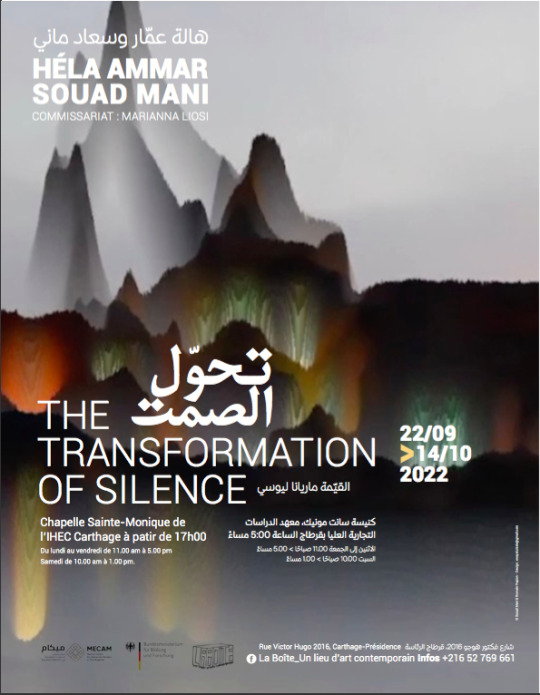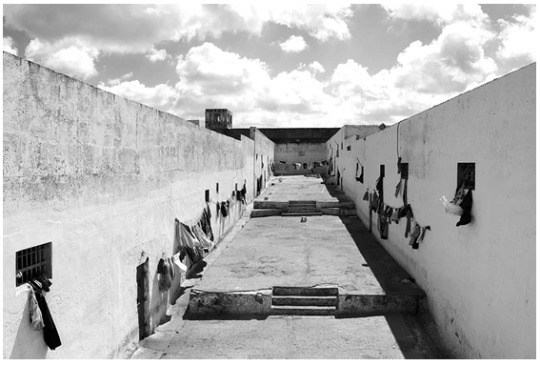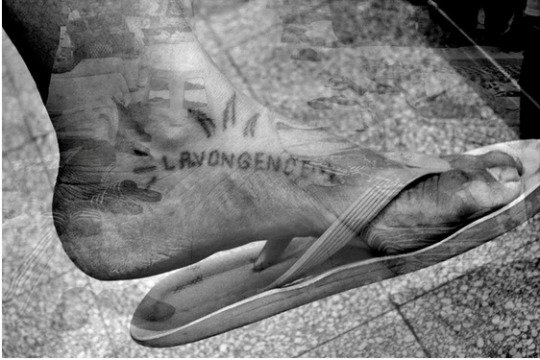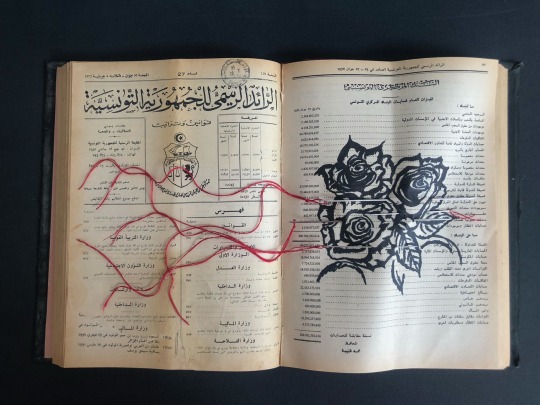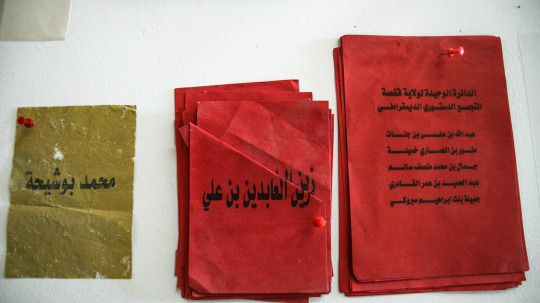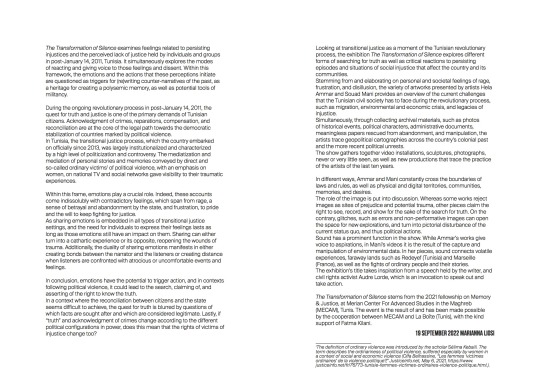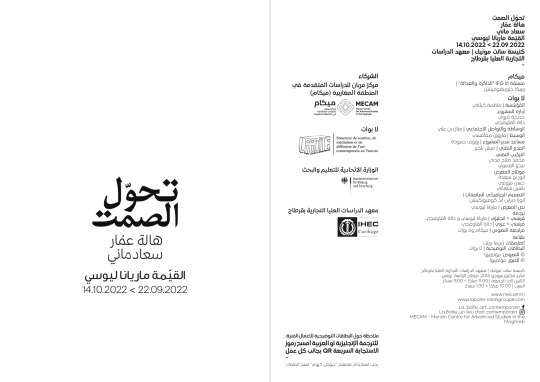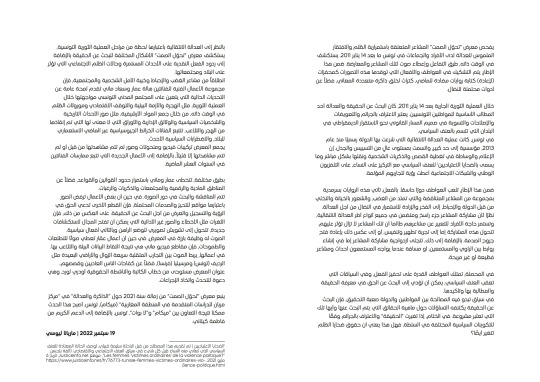Photo

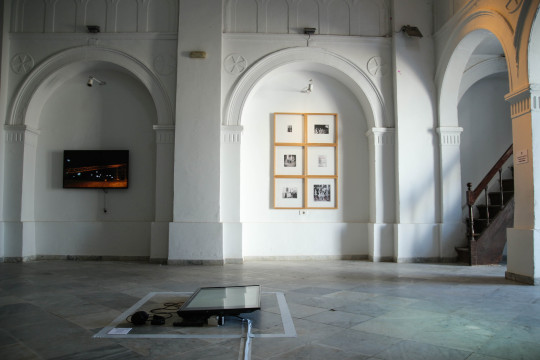



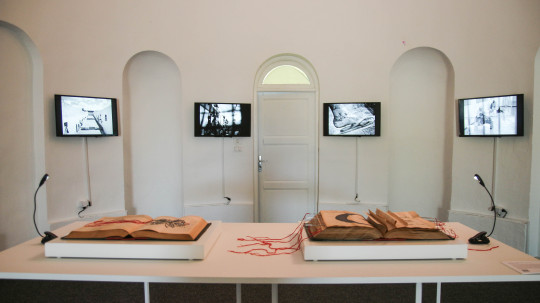



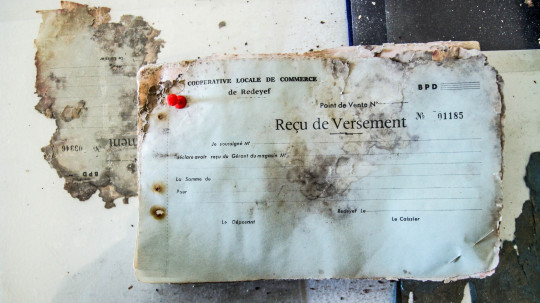
PRESS RELEASE
The Transformation of Silence
exhibition with Héla Ammar and Souad Mani
curated by Marianna Liosi
With a focus on persisting injustices in post-2011 Tunisia, The Transformation of Silence is an exhibition curated by Marianna Liosi that explores different forms of truth seeking, as well as the emotions linked to persisting social injustices that affect the country and its communities. Stemming from personal and societal feelings of rage, frustration, and disillusion, a variety of artworks by Tunisian artists Héla Ammar and Souad Mani seek to express dissent and political action. They provide an overview of the challenges that the Tunisian civil society has to face, from legacies of injustice, massive migration to severe pollution. Simultaneously, the works play as “glitches” in the current social and political system that can open the space for political change.
The show brings together performative videos, video installations, sculptures, photographs, as well as new productions and archive materials that trace trajectories through spaces, confronting historical moments and desires across times.
The title of the exhibition is inspired by a speech held by Afro-American writer, feminist, professor and civil rights activist Audre Lorde, which is an invocation to take action and speak out.
The Transformation of Silence is one of the outcomes of Liosi’s 2021 fellowship on Memory & Justice, at Merian Center for Advanced Studies in the Maghreb (MECAM), Tunis. The event is the result of, and has been made possible by the cooperation between MECAM and La Boîte (Tunis), with the kind support of Fatma Kilani.
Details:
Location: at Chapel of Saint-Monique, Rue Victor Hugo 2016, Carthage-Présidence, Tunis.
Duration of the event : From Friday 23 September, to Friday 14 October 2022.
Marianna Liosi is art curator, researcher, lecturer and cultural producer. She lives and works in Berlin. Marianna was MECAM Fellow 2021, within the Memory & Justice thematic cluster. She served as guest lecturer at the MA program Spatial Strategies at Weißensee Fine Arts Academy, Berlin (2021-2022) and as lecturer at LABA- The Free Fine Arts Academy in Rimini (Italy) (2019-2022). In 2020, she completed her PhD in Humanities, at the University of Ferrara, Italy. Her research interests focus on the question of engaged spectatorship, social networks as digital archives, affect and emotions, and digital memory as a tool of resistance. In the last years, Marianna has been focusing on education as curatorial practice. She has curated film screenings, workshops, exhibitions and she has lectured in art and academic institutions, such as HAU4, online, and MECAM’s Winter Talks #3, online (2022); European Month of Photography, Coculture, Berlin (2020); Haus der Kulturen der Welt, Berlin (2019); 00 Bienal de la Habana, Havana, Superior Institute of Fine Arts (ISBA) Sousse, Fondation Maison des sciences de l’homme, Paris, D21 Kunstraum in Leipzig (2018); Between Bridges, Berlin (2016). Marianna has published essays in artists’ books and academic edited volumes.
Souad Mani is a transmedia artist. She lives and works in Sousse, Tunisia. Her work is transdisciplinary, and it unfolds through techno-poetic experiments. In a geo-pictorial and geo-relational approach, she addresses questions about the status of the artwork, the artist and the viewer in the era of collective intelligence and interconnected objects. From photography and video to Land Art and data visualizations, Souad Mani’s works examine the possible transformations of a medium or a landscape.Her work has been exhibited at the Casa Árabe, Madrid (2021), the Biennial of Photographers of the Contemporary Arab World at the Arab World Institute, Paris (2017), and at the MuCem, Marseille (2015). She took part in various festivals in Tunisia, Spain, Italy, France, Germany, Czech and has participated in several group exhibitions in Tunisia.
Héla Ammar is a visual artist. She lives and works in Tunis, Tunisia. Besides her training in visual art, she holds a Phd in Law. Her photographs and installations address the stakes of memory. Identity and marginal communities are recurrent issues in her work. A selection of her photographs and installations is part of the permanent collection of the British Museum, London, the Arab World Institute, Paris, and the A. Slaoui Foundation’s Museum, Casablanca. Her work has been showcased in various international biennals and exhibitions such as Reflections at The British Museum, London (2021), The refugee week, featured by Shubbak Festival at the Victoria and Albert Museum, London (2019), Beyond borders at the Boghossian Foundation, Brussels (2019), Kerkennah#01, Kerkennah (2018), The Biennal of the Contemporary Arab world photographers, Arab World Institute, Paris (2017), Bamako Encounters, Mali (2017, 2015), Dak’art Biennal, Dakar (2016, 2014), Dream City, Tunis (2017, 2012, 2010).
1 note
·
View note
Photo
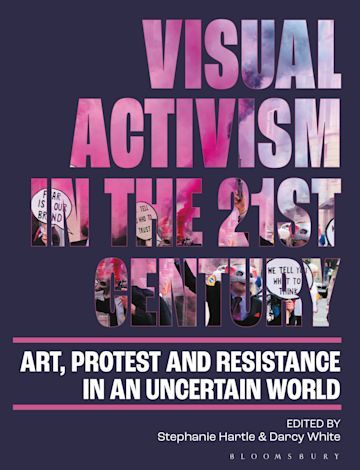
The world is in crisis, bringing activists and protesters onto the streets and into the public eye. More than ever, activism relies on spectacle and visibility in order to be noticed in the era of globalized capitalism and networked media. At the same time, a growing number of artists employ creative strategies to critique the establishment, act in resistance, and demand change. Visual activism of this kind is not new, but it is rapidly evolving.
This anthology presents 16 case-studies of visual activism from across the globe, providing an up-to-date picture of the impact of contemporary visual and art activism, and combining a scholarly interrogation of visual activism with an examination of how it works in practice. The case studies address a wide range of issues including human rights abuses; state violence; gender and sexuality; racism; migration; and climate breakdown. They examine a range of approaches from playful carnivalesque parades to extreme practices such as 'lip-sewing', and are drawn from a wide range of international contexts – from Europe and the US, to Iran, India, Pakistan, Tunisia, and China. This diverse scope enables readers to consider examples comparatively – noticing emerging trends and key differences to reveal how geopolitical and cultural factors play an important role in shaping activist practices.
This rich and timely collection provides a fresh perspective on the possibilities, limitations and politics of visual activism, as activists, artists, and curators respond to the changing world around them in this most uncertain of times.
Among great scholars from the Global South and North, I was honored to contribute to it with the chapter, “Montage and Vernacular Spectatorship: the Role Played by YouTube Channel AnarChnowa as a Tool of Visual Activism in Post-14 January 2011 Tunisia.”
0 notes
Photo
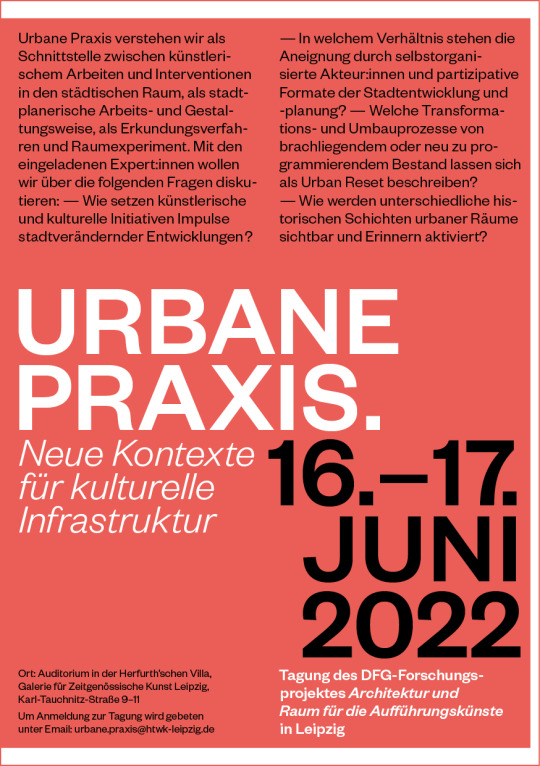

Digital commemoration and ephemeral memorials: performing the urban and online sphere
Paper by Marianna Liosi
Abstract
Through my paper, I investigate the digital sphere as a part of the public sphere. Within this framework, I will explore forms of commemoration that take place in the urban environment, and in the digital space. Questioning the permanence of memorials and its relationship with time and space, I will observe performance-based (performative) samples of memorials.
I will present two main case studies: the first is the Initiative 19. Februar Hanau, which was founded in the aftermath of the racist attack occurred in Hanau, Germany in February 2020. The initiative unfolds online through social networks and a website, as well as a widespread series of events that takes in different cities across the country.
The second consists in the performative action of Tunisian artist Souad Mani that results into the video De Mythes et de Choses. The artist illegally enters the phosphate washing plant of Redeyef, the infamous mining site in the south of Tunisia. The soundtrack of the video results from the transformation into sound of data recording high levels of pollution captured by a toolkit during the intrusion in the site.
Tracing the due differences between the types of memorials that these two cases studies embody, I will question how the digital shapes and affects the act of commemorating online and offline. Given the blurring borders between artist and militant interventions, I will analyze to what extent the digital commemoration can be interpreted as urban, and potentially activist, practice.
0 notes
Text
Digitale Raumstrategien /Digital Space Strategies
with artists: Ilghar Dadgostari, Fernanda Aloi, Jorge Baldeon, Sujatro Ghosh, Maricarmen Gutierrez, Tamara Margvelashvili, Cau Silva, Bo Xu, Karina Pino, Ricardo Sarmiento, Margarete Kiss and Leon Lechner, Hoayun Chung, Jongbin Park, Jae-Pyung Park, Marina Resende Santos, Graham Livingston, Sujatro Ghosh.
HAU4, 27 February -3 April 2022
A cooperation between weißensee kunsthochschule berlin and HAU Hebbel am Ufer.
The “Spatial Strategies” course at the Weißensee School of Art is concerned with artistic practice in urban space. Prof. Nasan Tur and Dr. Marianna Liosi have used the socio-political experiences under difficult circumstances, such as the pandemic, to develop a seminar series that considers digital space as part of the public sphere. In light of the capitalist structures of the internet, they ask whether and how artistic practices can overcome economic, gender and infrastructural barriers. What role does the audience play in this? What does artistic work in digital space mean if we assume that the public needs individual and collective care?
The individual or collective works presented at HAU4 take up a wide range of current questions. They are about personal and communal vulnerability as a trigger for social change, the potential and limits of digital space in addressing individual and societal memory and loss, the deconstruction of care within hierarchical structures, and the democratic accessibility and ecological sustainability of digital infrastructures. The proposed projects aim to reflect on the political transformations we can initiate in the public sphere in order to contribute to its permanent change.
Within the framework of the five-month cooperation, project ideas have emerged that the students present on the research platform HAU4. They show performances, text, video and sound material as well as social media interventions.
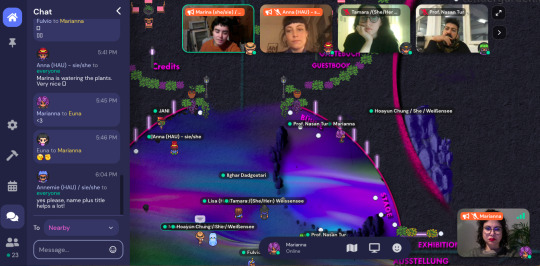
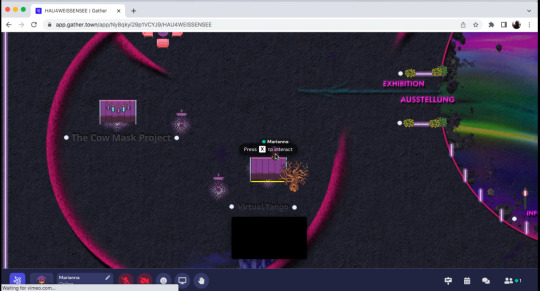
Digital Space Strategies, HAU4
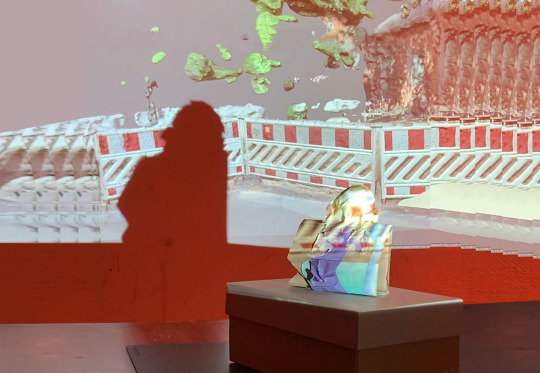
Jongbin Park, Jae-Pyung Park, Lost Ghosts, 2022, video (still frame). Courtesy: the artists
0 notes
Photo
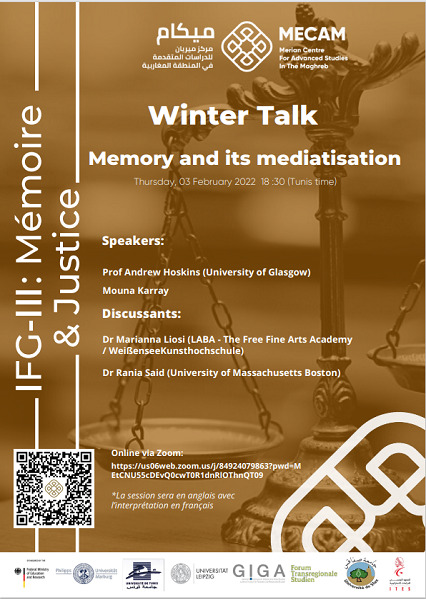
WINTER TALK: Memory and its mediatisation
What are the potentials and the challenges of mediatizing memory? What futures can mediatised memory promise? Through a reflection on collective memory and its limits, this panel is both an attempt to answer these questions from a theoretical and artistic perspective, and also an invitation to reflect on the role played by media in the ethics of documenting, forgetting and re-narrating the past.
The Winter Talk takes place online via Zoom on Thursday, 03 February 2022, 18h30 – 20h00 (Tunisian and Central European time).
Guests:
Prof. Andrew Hoskins (University of Glasgow) and Mouna Karray participate in this panel as guest speakers and Dr Marianna Liosi (Weißensee Kunsthochschule Berlin / The Free Fine Arts Academy in Rimini) and Dr Rania Said (University of Massachusetts Boston) as discussants.
0 notes
Link
Abstract:
“This article is a reflective text by an art curator interested in exploring the boundaries between video activism, spectatorship, and pedagogy. It proposes new ways of critically understanding the terms “activist,” “participation,” and “militancy” in the context of an expanded notion of the image and the role of the spectator. Emerging from field notes, the article narrates and shares the experiences of engaging students at workshops for “Between Broadcast – a project around activist videos,” held at at fine art academies and universities in Leipzig, Düsseldorf, and Bergamo. The practical aim of the workshops was to introduce and engage students with the subject of so-called activist video clips on YouTube. The students were asked to find, select, and discuss militant videos and, subsequently, to create a montage from them. The conceptual aim of the workshop was to reflect upon video spectatorship online and what that means, the agency of the spectator, and the possibilities of their active participation in the process of viewing. The outcomes of the workshops were the development of critical thinking of the students concerning the subjects of online video, digital empathy, their engagement with videos as individual viewers and as a collective, and the power of montage as a narrative and activist tool”.
Marianna Liosi
Video Journal of Education and Pedagogy, https://doi.org/10.1186/s40990-018-0024-0
© The Author(s) 2018
0 notes
Text
Between Broadcast-Workshop (2016-ongoing)
“Between Broadcast - Workshop” is an ongoing laboratory for discussion and creation at universities, conceived and curated by Marianna Liosi, which started in November 2016. It stems from "Between Broadcast - a project around activist videos" originally initiated by Marianna Liosi in collaboration with Between Bridges, in June 2016 at Between Bridges, Berlin. The project was meant to explore the bond between militancy through videos, empathy and digital memories as well as the activism of the spectator-user through montage. "Between Broadcast - Workshop" adresses to students and is intended to question what activist videos mean, and the empathic relationship that viewers establish with them, especially those found on YouTube. The project aims also to stimulate the students to a survey of the individual’s memories: a recollection of historical episodes that one can remember thanks to the online clips consumed on YouTube, able to shape the individual’s memories of those events, and in doing so, that have become travel companions over time.
“Between Broadcast - Workshop” took place variously at the Institut Supérieur de Beaux Arts, Sousse, Tunisia (2018); as part of the seminar "Creative Writing and Storytelling", held by Marianna Liosi, at the University of Potsdam, Germany (2018); at Hochschule für Grafik und Kunst Leipzig, Germany (2017), as hosted by the Expanded Cinema class of professor Clemens von Wedemeyer (November 2017); at the Academy of fine Arts in Bergamo, Italy in the Sound Design class of professor Riccardo Benassi (February 2017); at Kunstakademie Düsseldorf, Germany (2016), as an extra workshop over the winter semester.
Background:
“Between Broadcast” started in response to “Meeting Place” an umbrella of weekly events launched by photographer Wolfgang Tillmans at Between Bridges in April 2016 that ran in parallel to his EU Referendum campaign (a project conceived in response to the UK’s Brexit vote of June 23rd, 2016, which consisted of a counter campaign of anti-conservative propaganda posters plastered in the streets of several British towns). Within this framework, “Between Broadcast - a project around activist videos” was conceived as a one-month long series of public events. It started with the creation of a playlist of clips recently uploaded on YouTube, and it was collaboratively initiated together with Between Bridges team members (http://www.betweenbridges.net/meeting...) Over the course of the one-month screening of the forty-minute playlist, visitors were free to contribute to it with their own selection of videos from YouTube and were invited to deal with the same challenging investigation of their own individual memories of and through mediated images. (see: https://www.youtube.com/watch?v=XCg95...)
In November 2016, “Between Broadcast” turned into a laboratory for discussion and creation at universities.
1 note
·
View note
Photo
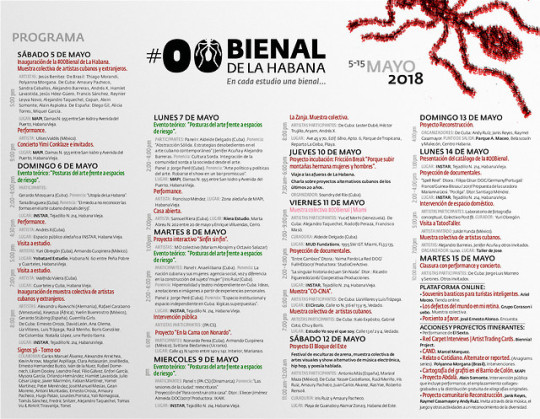
“Spell Reel” (2017) by Filipa Cesar
Film screening curated by Marianna Liosi, accompanied by a critical text (Engl/Span)
14th May 2018, at INSTAR, Tejadillo N. 214, Habana Vieja
#00 Bienal de la Habana, 5–15 May 2018, Havana, Cuba
Spell Reel: a filmed political essay about everyday resistance
by Marianna Liosi
(English version)
It can become an obsession for us to want to control the image that one day we produced accidentally, saying 'that's for history'. [...] Yet the image gives itself a new life, a new destiny, with or without us. It frees itself of our guardianship.
—Sana na N'Hada, Our image and ourselves, 2015
Independent from their producer, images want to be free, to transform, and to live. They ask us as viewers to make it happen. How do we come together with them?
From Cuba in 1967 to Guinea-Bissau, through Berlin and across countless villages and towns, peninsulas and islands, all over the globe, until today, the footage composing the film project Spell Reel (2017) by artist Filipa César has struggled to exist across chronicles and continents.
As claimed by Sana Na N’Hada, “In war, the enemy shoots the person with a camera before the person with the gun”.
Spell Reel is a resisting film, because of its object. It is the discovery and rescue of a minor and damaged part of a much wider archive of film footage shot by revolutionary filmmakers from Guinea-Bissau, which include Sana Na N’Hada, Flora Gomes, José Bolama Cobumba, and Josefina Crato. These filmmakers studied cinema at the Cuban Institute of Cinematographic Art and Industry, and at the directive of Guinea- Bissau’s Amilcar Cabral, documented the struggle for the liberation of the state from Portuguese domination (1963–74). This is the key event that initiated the long term research project and archival work titled “Luta ca cada inda” (The struggle is not over yet), a project initiated by Filipa César and developed in collaboration with the abovementioned filmmakers and various co-authors.
Spell Reel is a resisting film because of its perspective. Taking inspiration from the gaps (missing footage and sound) in the invaluable cinematic materials found, and by not attempting to fill them, César approaches with a sensitive touch the past and historical background of the films and their authors, which she interweaves with the present. Creating a dialogue between the archival footage and the communities that the images have unconsciously fostered, she engages a process for the construction of collective memories. Spell Reel is an invitation to look also at these voids as a place for the creation of new stories, and as viewers, a call to engage and write our own history.
Spell Reel is a resisting film because of its form, and montage is at the core of it: black and white footage, upside down or damaged, juxtapositions with contemporary shots, and poetic commentary all echo aesthetically a non-linear way of seeing and thinking. This use of montage also mirrors the experience by César of confrontating and manipulating together with many collaborators the found reels, first in Guinea- Bissau and then in Berlin, where they were digitized. Selecting, re-using incomplete and unstable reels, revisiting, and editing them, César stretches to the extreme the possibilities of a found repository. As well, out of its fragments, she creates an expanded and endless archive.
Spell Reel is a film born by encounters: by César, the revolutionary filmmakers, and all the people with whom they have collaborated. César’s film also proactively traces trajectories of engagement and viewing, as for instance, among the Guinean community: the archival films and their authors were largely unknown until their public screening by means of mobile cinema. This format is a cultural method that was already used in Cuba after the revolution of 1959, as a way of engaging and educating citizens in the countryside, and in turn, a legacy of Russian agit-prop trains used in the 1917 Revolution through to 1935.
Furthermore, Spell Reel generates further encounters in its movement between places. It connects the Guinean community with the Cuban one, where spectators from both countries watch juxtaposed visual testimonies from their respective histories, which carry a great political and social value of solidarity between two distant geographies. And finally, it has bonded viewers around the world to a story of discovery, loss, freedom, solidarity, and struggle, which expands across time, place, and people. Through watching Spell Reel, we do not relive any past; instead, we are drafting our future.
(Spanish version)
Spell Reel: un ensayo político filmado sobre resistencia cotidiana
by Marianna Liosi
Translation by Francesca Boenzi
Puede convertirse en una obsesión para nosotros querer controlar la imagen que un día produjimos accidentalmente, diciendo 'eso es para la historia'. [...] Sin embargo, la imagen da a sí misma una nueva vida, un nuevo destino, con o sin nosotros. Se libera de nuestra tutela.
-Sana na N'Hada, Nuestra imagen y nosotros mismos, 2015
Independientes de su productor, las imágenes quieren ser libres, transformarse y vivir. Nos piden como espectadores para que esto suceda ¿Cómo nos unimos a ellas?
Desde Cuba en 1967 hasta Guinea-Bissau, pasando por Berlín y a lo largo de innumerables pueblos y ciudades, penínsulas e islas, en todo el mundo, hasta el día de hoy, el metraje que compone el proyecto Spell Reel (2017) de la artista Filipa César ha tenido dificultades para existir a través de crónicas y continentes. Como afirma Sana Na N'Hada, "En la guerra, el enemigo dispara a la persona que lleva una cámara antes de la persona con la pistola".
Spell Reel es una película resistente, debido a su objeto. Es el descubrimiento y rescate de una parte pequeña y dañada de un archivo mucho más amplio de metrajes filmados por cineastas revolucionarios de Guinea-Bissau, que incluyen a Sana Na N'Hada, Flora Gomes, José Bolama Cobumba y Josefina Crato. Estos cineastas estudiaron cine en el Instituto Cubano de Arte e Industria Cinematográficos, y bajo la dirección de Amilcar Cabral de Guinea-Bissau, documentaron la lucha por la liberación del Estado desde la dominación portuguesa (1963-74). Este es el evento clave que inició el proyecto de investigación a largo plazo y el trabajo de archivo titulado "Luta ca cada inda (La lucha aún no ha terminado)", un proyecto iniciado por Filipa César y desarrollado en colaboración con los cineastas mencionados anteriormente y varios coautores.
Spell Reel es una película resistente debido a su perspectiva. Inspirándose en las lagunas existentes (metraje y sonido perdidos) en los invaluables materiales cinematográficos encontrados, y al no intentar llenarlas, César aborda con un toque sensible el pasado y el contexto histórico de las películas y sus autores, entrelazándoles con el presente. Creando un diálogo entre el metraje de archivo y las comunidades que las imágenes han fomentado inconscientemente, la artista se involucra en un proceso para la construcción de memorias colectivas. Spell Reel es una invitación a ver también estos vacíos como un lugar para la creación de nuevas historias, y una llamada a nosotros como espectadores, para participar y escribir nuestra propia historia.
Spell Reel es una película resistente debido a su forma, y el montaje es su núcleo: imágenes en blanco y negro, dañadas o montadas al revés, yuxtaposiciones con tomas contemporáneas y comentarios poéticos, todo evoca estéticamente una forma no lineal de ver y pensar . Este uso del montaje también refleja la experiencia de César de confrontar y manipular junto con muchos colaboradores los carretes encontrados, primero en Guinea-Bissau y luego en Berlín, donde fueron digitalizados. Al seleccionar, reutilizar los carretes incompletos e inestables, revisarlos y editarlos, César extiende al extremo las posibilidades de un repositorio encontrado. Además, a partir de sus fragmentos, ella crea un archivo expandido e interminable.
Spell Reel es una película que nace de encuentros: por la misma César, los cineastas revolucionarios y todas las personas con las que ellos han colaborado. La película de César también rastrea de manera proactiva las trayectorias de participación y visualización, por ejemplo, entre la comunidad guineana: las películas de archivo y sus autores fueron en gran medida desconocidos hasta su proyección pública a través del cine móvil. Este formato es un estrategia cultural que ya se usó en Cuba después de la revolución de 1959, como una forma de involucrar y educar a los campesinos y, a su vez, un legado de los trenes agit-prop rusos utilizados en la Revolución de 1917 hasta 1935 .
Además, Spell Reel genera aun más encuentros en su movimiento entre lugares. Conecta la comunidad guineana con la cubana, donde espectadores de ambos países miran testimonios visuales yuxtapuestos de sus respectivas historias, que conllevan un gran valor político y social de solidaridad entre dos geografías lejanas. Y, por último, ha unido a los espectadores de todo el mundo a una historia de descubrimiento, pérdida, libertad, solidaridad y lucha, que se expande a través del tiempo, el lugar y la gente.
Al mirar Spell Reel, no revivimos ningún pasado; en cambio, estamos redactando nuestro futuro.
0 notes
Text
Tentative Matters
When Things Occur, 2016 by Oraib Toukan
Dialogue, from the series Citizen with a Movie Camera, 2013, by DOX BOX
29 November 2017, at Luru-Kino in der Spinnerei, Spinnereistr. 7, 04179 Leipzig
Film screening curated by Marianna Liosi, as part of Der Bau der Intrige – Über Filme die was machen, initiated and curated by Lena Brüggeman and Clemens von Wedemeyer

Dialogue, from the series Citizen with a Movie Camera, 2013, by DOX BOX, 19 mins, still.
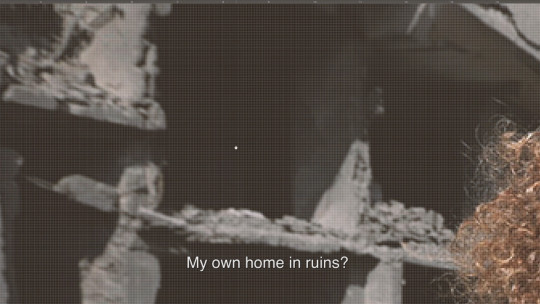
When Things Occur, 2016 by Oraib Toukan, 29 mins, still
1 note
·
View note
Text
The digital revolution in Havana: between liberation and submission
by Marianna Liosi, opendemocracy.net, 27th July 2018
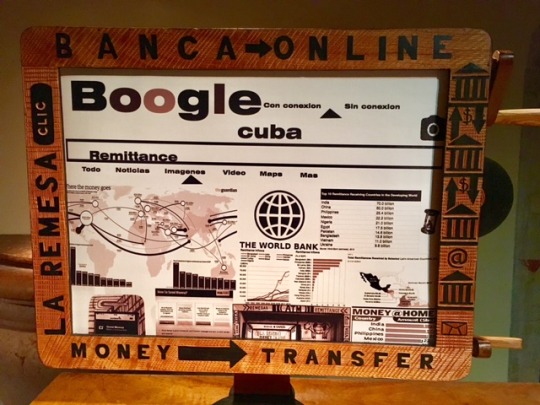
Abel Barroso, Cuban style cyber lounge virtual reality, 2017. Courtesy: Gallery On Greene
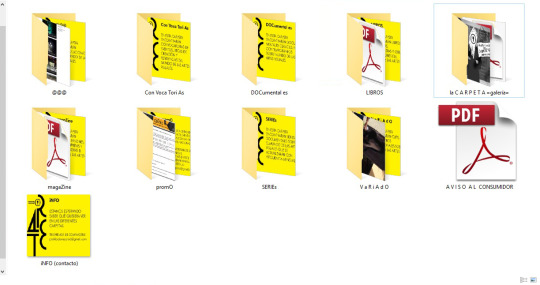
Nestor Siré, !!!ART Section, 2016-2017, monthly intervention in the Weekly Package and independent digital exhibition space. Folder’s structure in the !!!ART section. Courtesy: the artist
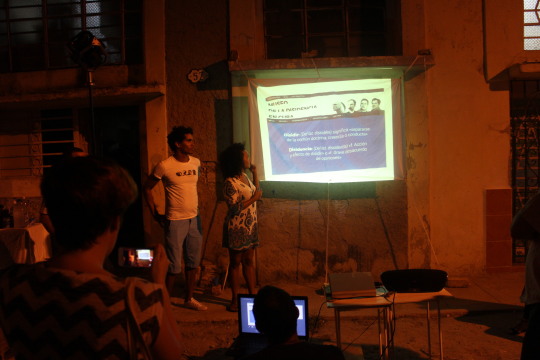
Museo de la Disidencia, http://museodeladisidenciaencuba.org/, a project by Yanelis Nuna and Luis Manuel Otero Alcantara. Public presentation in February 2017, Havana, Cuba.
0 notes
Text
Image Testimonies – Witnessing in Times of Social Media (Berlin, 13-15 Jul 17)
International Symposium hosted by the Collaborative Research Center “Affective Societies”, Project B01 “Affective Dynamics of Images in the Era of Social Media”, Free University Berlin
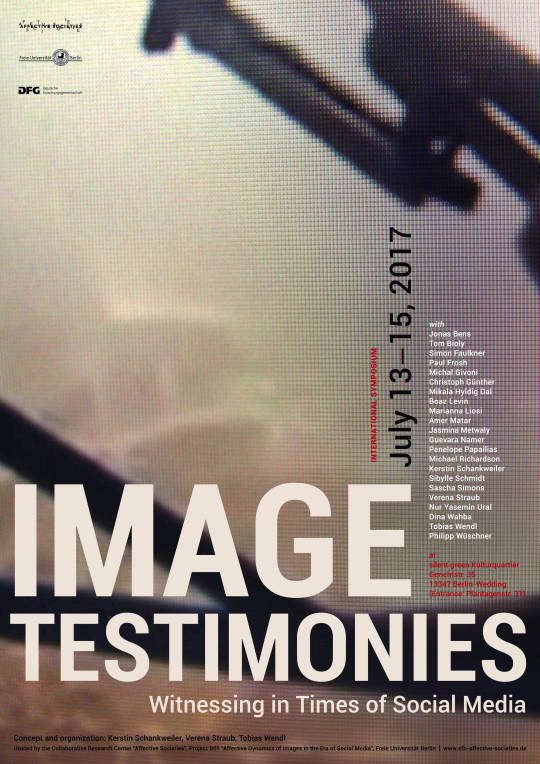
Recent political conflicts signal an increased proliferation of image testimonies shared widely via Social Media. Although witnessing with and through images is not a phenomenon of the internet era, image practices and politics in Social Media as much as new technology have enabled individuals to record, upload, and share images directly via mobile devices, which makes nearly everyone a potential witness. In relation to their ability to give and to create evidence, the special efficacy of image testimonies seems to lie in their ability to affect, to move, or to mobilize. Witnessing, especially when unfolding in Social Media, needs to be defined as a collective and relational practice with the effect of forming communities, and provoking further image testimonies. What exactly is being testified by these various forms of witnessing can only be studied from multiple perspectives and necessitates complicating the “truth-claims” that are made.
Against this backdrop the symposium seeks to contribute to the ongoing debate on the topic of testimony and witnessing. Which different concepts of witnessing are at stake in image testimonies? What is the role of the spectator? How can we think of the relation between mediated forms of witnessing and the body? A guiding theme of the symposium is these images’ affective dynamics in order to shape a new approach on testimony theory.
PROGRAM
THURSDAY, July 13, 2017 1
7:00 – 17:30 Kerstin Schankweiler & Verena Straub (Berlin): Welcome and Introduction
17:30 – 18:15 Michal Givoni (Jaffa): Bearing Witness, Yet Again: Occupation Testimonies and Left-Wing Despair
18:15 – 20:00 Screening and Panel Discussion: Citizen with a Movie Camera (DOX BOX) and videos from Syria Mobile Film Festival. Marianna Liosi (Berlin/Ferrara) in conversation with Guevara Namer (Berlin) and Amer Matar (Berlin)
FRIDAY, July 14, 2017
9:30 – 10:00 Coffee und Warm-Up WITNESSING DESTRUCTION (Moderation: Mikala Hyldig Dal, Berlin)
10:00 – 10:45 Verena Straub (Berlin): “Living Martyrs” – Testifying What is to Come
10:45 – 11:30 Tom Bioly (Jena) & Christoph Günther (Halle): The Islamic State’s Iconoclasm and Iconography
11:30 – 12:00 Coffee Break
12:00 – 12:45 Tobias Wendl (Berlin): From Cape Town to Timbuktu: Iconoclastic Testimonies in the Age of Social Media
12:45 – 14:30 Lunch Break
AFFECTIVE WITNESSING (Moderation: Nur Yasemin Ural, Berlin)
14:30 – 15:15 Kerstin Schankweiler (Berlin): “Moroccan Lives Matter” – Practices and Politics of Affecting
15:15 – 16:00 Michael Richardson (Sydney): Drone’s-Eye View: Affective Witnessing and Technicities of Perception
16:00 – 16:45 Coffee Break EPISTEMOLOGIES OF TESTIMONIES (Moderation: Dina Wahba, Berlin)
16:45 – 17:30 Sascha Simons (Bonn): A Witness for the Witness. On the Socio-Technical and Socioaesthetic Epistemology of Web Video Testimonies
17:30 – 18:15 Jonas Bens (Berlin): Affective Dimensions of Visual Testimony and Audio Evidence before the International Criminal Court
Break 19:00 – 20:30 Lecture Performance by Jasmina Metwaly (Berlin/Cairo)
SATURDAY, July 15, 2017
SOCIAL MEDIA PRACTICES (Moderation: Boaz Levin, Lüneburg/Berlin)
10:00 – 10:45 Simon Faulkner (Manchester): Palestinian Photojournalists, Facebook, and the Political Self as Witness
10:45 – 11:30 Penelope Papailias (Thessaly): Selfie Videos of Black Death: Live Mobile Witnessing and the Radical Gesture of Testimonial Self-Imaging
11:30 – 12:00 Coffee Break
12:00 – 12:45 Paul Frosh (Jerusalem): Screen Shot: Witnessing, Poetics and the Digital-Social Trace
12:45 – 13:15 Sibylle Schmidt (Berlin) & Philipp Wüschner (Berlin): Concluding Remarks
Conception and Organization:
Kerstin Schankweiler, Verena Straub, Tobias Wendl
Free University Berlin
CRC 1171 Affective Societies
Project B01 “Affective Dynamics of Images in the Era of Social Media”
Habelschwerdter Allee 45
D-14195 Berlin
#guevaranamer#amermatar#citizenwithamoviecamera#doxbox#syrianmobilefilmfestival#affectivesocieties#symposium#youtube
0 notes
Text
Spectatorship and Engagement in Public Space
Art projects by Wolfgang Tillmans, Riccardo Benassi and Lara Baladi that reflect upon the role of the viewer and the generation of new content through observation.
Lecture by Marianna Liosi, What do images in public space do? - Symposium, University of Geneva, Geneva, 18 January 2017
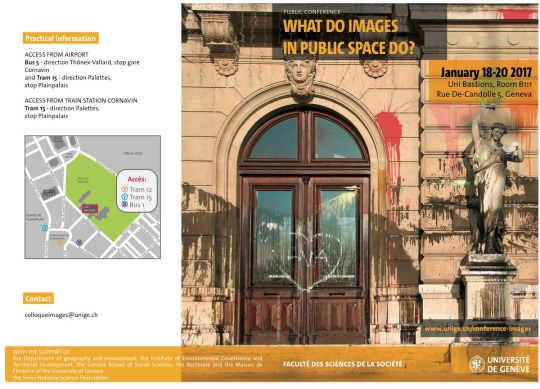
Abstract:
Taking inspiration from a series of visual interventions by artists in the public space, my proposal aims to reflect on spectatorship in relation to images in the public environment as well as to explore the viewer’s engagement with these visual materials and which outcomes this individual agency can produce on a larger/collective scale.
I’ll present three art projects:
1. The EU Referendum campaign by photographer Wolfgang Tillmans in view of UK’s vote on 7th June 2016 for Brexit (the exit of United Kingdom from EU) by mean of anti-conservatives propaganda posters affixed in the streets of several British towns;
2. Daily Desiderio, the sculpture by Riccardo Benassi stating the search by the artist of his interlocutors for a daily dialogue. Daily Desiderio is going to be installed by the end of 2016 at City Life in Milan (a contemporary park of contemporary art currently under construction);
3. The media initiative Tahrir Cinema, by artist Lara Baladi, consisting of video screenings in the street during the 2011 Egyptian uprising. These public projections served as public platforms to build and share an archive on and for the revolution.
These three cases show the emancipatory potential of the image and open to an exploration of the emotional, empathic relation established with the viewer. How does the experience of images through vision generate agency and involvement? Assuming Jacques Rancière’s perspective on spectatorship, who states that “Every spectator is already an actor in her story; every actor, every man of action, is the spectator of the same story” the act of viewing is interpreted as potentially creative and generative of new discourses. Since the spectator is immersed in the space he/she lives and therefore he/she experiences the same spectacle (intending with this word a broad range of situations) he observes, for this reason image and viewer seems to contribute to the creation of new narratives, based on the act of seeing. How? The proposal introduces notions of affection, empathy as feelings that facilitate the experience of the image’s aesthetics, and therefore of its content as well as that stimulate to the individual’s response.
More info: http://www.unige.ch/sciences-societe/geo/conference-images/fr/
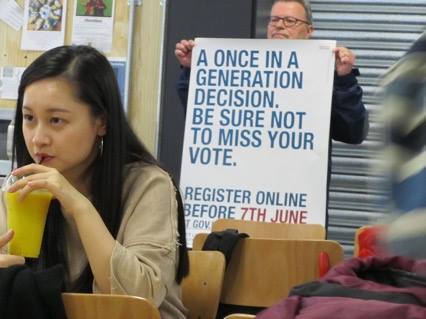
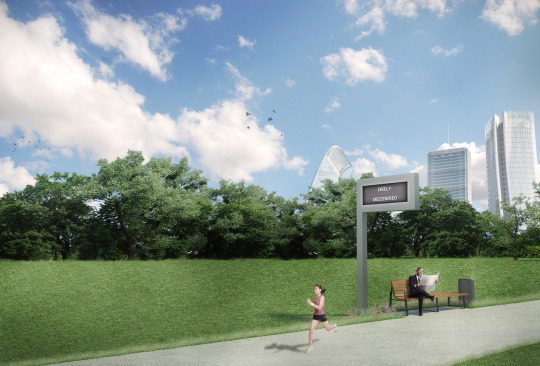
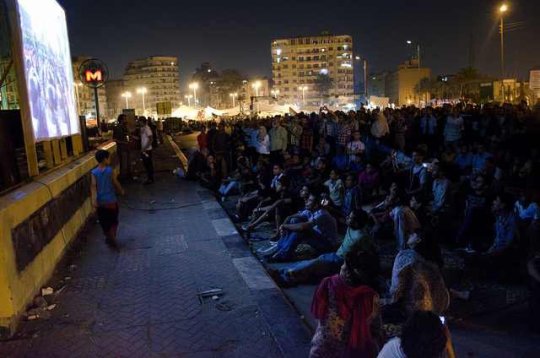
0 notes
